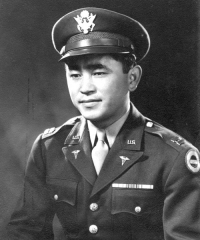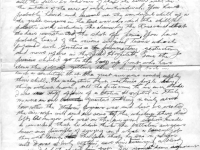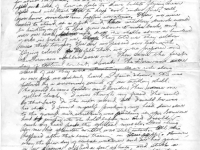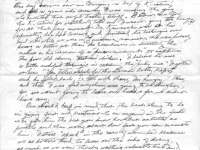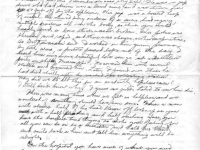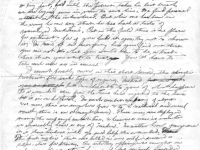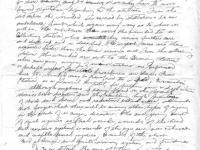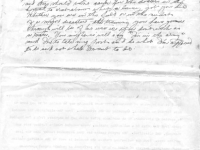Dr. Richard Kainuma, along with Dr. Issac Kawasaki, was one of the two medical doctors who accompanied the battalion in June 1942 when it left Hawaii. While the battalion was training on the mainland, he was promoted to captain and was described as a tireless worker and a very skilled doctor by the battalion’s Executive Officer, Major Jim Lovell. Shortly after the battalion landed in Italy and entered into combat, Kainuma was seriously injured when a heavy weapons convoy in which he was riding slid off a muddy road. He suffered chest injuries, including four broken ribs.
Concerned that he would be sent for convalescence and then to a replacement unit away from the 100th, Dr. Kainuma arranged with the 34th Division’s chief surgeon to be specially assigned to the 100th’s aid station while he healed.
His son, Robert, has shared the notes Dr. Kainuma wrote on treating the wounded under battlefield conditions. Unfortunately, this document was not dated.
Transcription of Dr. Kainuma’s notes
1
Care of Wounded in the Field
In the event of any major disaster our biggest and most urgent problem will be the efficient care of the injured. In order to achieve this end we must be prepared and be trained for whatever may happen. If we are to give the best of care to these people we must start from the very moment they are injured. The faster we are on the spot and the faster we take care of them the better will be the outcome of the care of each individual. You have probably heard and marvel at the wonderful skill of a the great surgeons in the last war who did the skillful plastic work, including the claim by the Russians that the have reconstructed the shot off penis. You have probably heard of the various surgical teams which performed such operations as pneumectomy gastrectomy, and nerve repairs in the Field Hospitals. Some the praises should go to the boys up front who have done the job of getting these wounded back in such a condition that the great surgeons could apply their skill. The realization that at times people say things without moving [tell?] the facts came to me [once?] while I was also staff officer of a Station Hospital in Italy. We were in our barracks quarters talking mainly about how rotten the Italian Cogniac was and how we wished the air corp will send us some of the whiskeys they had left. A major who was on the surgical section made a remarked that he didn’t think the battalion surgeons knew any principles of surgery and what a lousy job they were doing. The fact that he was a major and I was a lowly captain, save him from receiving a bloody nose. I politely cursed him out. Sir, you’re a damn ignorant bastard, Sir. The basic procedures of caring for the injured in case of a major disaster here in Honolulu differ very little from the treating of wounded and injured in the battlefield. With this in mind, I will attempt to give you a rather meager instruction on the care of wounded in the field.
2
The hardest thing to do in case of a sudden emergency is to “keep cool, calm and collected”. Perhaps if you know what to expect and when to expect it is easier to be prepared. During our training period in Mississippi we were made to go through a so-called infiltration course. Actual machine gun bullets were fired about 3 feet above the ground and we crawled through barbed wire and mud puddles for about 100 yards. We we told that this course will give us an idea of how it feels to have bullets flying near us and will teach us to keep “cool” under fire. Well, you know, accidents can happen sometimes. Then, we were asked to stand at a spot and the artillery bunch would be kind enough to fire from about 5 miles back, and over our head, and drop the shells about a hundred yards in front of us. They told us they seldom miss their target. Yes sir, we passed our test with flying colors. We felt that we were prepared and the Germans couldn’t scare us. Then come the first day of actual combat. Hoorah! The Germans were scared of us they were retracting. As we rode along on our jeep we suddenly heard a faint “whoom”. This was followed by a screaming sound of an artillery shell. The sound became louder and louder. Then someone yelled “duck”. I never thought my friend Ike could be that fast. In the next second all I could be was his shoes. I found myself pushing my head down close to the ground and something was pushing it up. Someone had jumped into the hold before me and I couldn’t push my head past the gluteal muscle. Good thing for me his sphincter control was still intact. All this happened after that basic training in Mississippi. However, when the first day of combat was over and we had given a few plasma, applied a few splints, and stuck a few bayonet-gun along side the dead ones, we felt that we had done a fair job and started to collect our wits and talked of more pleasant things like trying to imagine a small can of pork and beans was a large juicy T-Bone steak.
3
Our commanding officer once told us that war is a serious bus[ious?] for its not like maneuver and it'[s?] life and [d?]eath matter. How anyone can be serious all the time and not end up in a phsyciatric ward is beyond me. After seeing and treating some of the wounded that have stepped or tripped on land mines or booby traps we were pretty scared of them. While we were working we were mighty serious. But we had our crazy moments, during the lull moments or “rest-periods”. One day someone saw me burying a box of K-ration, and for a grave side ceremony I was cussing the guy who invented that awful tasting stuff. I didn’t care for the K-ration for something told me I wasn’t going too hungry, for at that very moment Dr. Kawasaki was at his specialty. He had learned and practiced his technique over and over while we were in the Louisiana maneuver. He was probably doing a better job than Ike Eisenhower in directing the medics on his version of a “pincer movement” to capture the poor old skinny Italian chicken. I believe he uses a little modified technique in catching the “porky ones”. I yelled at him, “You better watch for the German booty traps,” and he yelled back, To hell with them, I’m hungry.” [Sure?], and there I was glad everything was going to be alright, for, we weren’t going to lose our heads for we didn’t have any.
One should keep in mind that the best thing to do in giving first aid treatment to an injured in the field is to give him the best you know how, but as little as possible and then worry about how fast you can evacuate him. I stress “speed” in the care of wounded because we as doctors tend to lean on the side of doing as much as we can, thereby wasting valuable time and supplies. How well I remember a particular insidence during our last crossing of the Volturno River. We we told to cross the river at 5 minutes after midnight. All day and all night we planned our job. We went out on reconacense mission, we studied the map carefully to easiest and fastest trail to evacuate our wounded, we checked our supplies, and gave our plans to the ambulance corp so that the could support us. After an intense bombing
4
and concentrated shelling of the enemy position we pushed off and crossed the river. How the Germans survived the bombing and shelling is beyond my imagination, but they welcomed us with everything. How can anyone think in the midst of all that noise? As I told you before we didn’t have any head to think with. Our casualties were many. I remember Ike trying in vain to [?] officer whose chest was almost almost sawed off by a burst of machine gun fire. In the midst of all this I remember one case very well. He was a jeep driver who had driven over a land mine, and was thrown over 50 feet off by the explosion. His jeep was a twisted heap of metal. He showed every evidence of a severe head injury, multiple fractures all over the body, so that you would hardly find a bone that wasn’t broken. His pulse was thready, and rapid, and there was cheyne-stokes respiration. As Dr. Kawasaki and I worked on him giving plasma by both arms, a picture passed before me, of the day I heard him sing some beautiful love songs at a Battalion party in Shelby, Mississippi. We covered him with several blankets and evacuated him. Later I found out that he had died shortly after he reached the collecting station. Why did we do all this for an evidently hopeless case? I still don’t know why. I guess we just hated to see him die.
There were many times when we felt so helpless and we wondered if something should have been done. When a man with almost half of his head blown off looks up at you with a half pleading and half smiling face, you have the hardest time trying to choke your feeling for all you can do is be a minister, and hold his hand and smile back at him and tell him everything will be alright.
In the hospital you have most of what you need. But out there our water supply was limited. Most of the time you worked in the dark like a blind man, feeling for the wounds. Whoever heard of aseptic technique and the other luxuries we enjoy in the hospital. If you can save yourself for another day of combat your were considered a good battalion surgeon.
To me the most important problem was the matter of evacuation. The seriously wounded ones had a better
5
chance when evacuation was fast. And yet at one particular battle it took a wounded about 24 hours to be carried out to an ambulance point. Several teams of litter squads carried the wounded through narrow paths over snow covered hills, and muddy valley and along rocky hills to get the wounded out. I believe we lost many of them on the way out.
In our private p[?] of medicine sentiment plays a big part, for until the patient takes his last breath we are trying even in vain to save him. We find personal interest in the individual. But when one has been in the army he can say that he has had a taste of socialized medicine. Out in the field there is no place for sentiment, for if you feel it you try not to show it. In time of an emergency here you find out that you can not do what you would like to do, or treat those that you want to treat. You’ll have to take each case as it comes.
I cannot possibly cover, in this short period, the specific treatment for each type of injury. Instead, let me give you an example let me discribe to you of what happens to a wounded care from the time he is injured to the time he is in a hospital. In each combat company of about 200 men, there are anywhere from 2 to 4 medical aid men (usually there is one or maybe more). These men, are deployed among the company’s combat line. Whenever a man is wounded we invariably hear a cry of “medic”. No matter how dangerous it is, these “medics” will go and help the wounded. The first “medic” that was killed in our outfit received a Silver Star for bravery. An artillery officer was caught in a barrage of mortar fire and was seriously wounded. This medic had crawled over the hill to bring him back. As he carried that officer over his shoulder a shell landed directly on them and both of them were killed. The wounded is then treated and tagged and is brought to the aid station by a litter squad. Our aid station could be anywhere near the front line where the enemy cannot see you. We usually never had fancy wall tents. If we were lucky we could find a fairly comfortable Italian farm house. Here at the aid station the wounds are
6
rechecked. Tourniquets are checked or removed as necessary. Dressings may be reapplied. Tags are rechecked, and additional information added. Plasma is given if necessary. Even good water, and hot drinks may be available depending on the situation. There is no time for debridement, and repair of wounds or any major surgery. Speed is the key note of treatment for more casualty may be coming or we may have to move forward or withdraw, depending on the situation. From the aid station the wounded are carried by stretcher to an ambulance point which again may vary as to where it will be. The ambulance then carry the wounded to a Collecting Station, where they receive further care and check-up, end a classified. The urgent cases are then evacuated faster than the less serious ones. From the collecting station the wounded are sent to the Clearing Station where emergency surgery of minor nature are performed or perhaps urgent operative procedures are done. From here the wounded may be transfered to a Field, Evacuation, Station, or a General Hospital for further care & disposition – although emphasis is being placed on the possible atomic bomb disaster and the resulting high percentage of shock and thermal and radiation burn cases, we must not forget that there will be many other types of injury in the event of a major disaster. The emergency care of such injuries as flesh wounds, wounds of the head and nervous system, wounds of the eye, ear nose & throat and maxillo facial injuries; wounds of the chest and abdomen and genito-urinary system and fractures.
To go in detail the care of these specific types of injuries will be too boring and would take too much time. Let me remind you of only the basic principles, such as relief of pain for the alleviation of suffering and prevention of surgical shock, control of hemorrhages, treatment of shock and prevention of further contamination of wounds. Remember to splint the fracture on the spot before evacuation. If tourniquet are used make a notation on the tag so that proper care can be followed up.
7
And when roads are blocked, bridges are torn, and the ambulance that was supposed to support you is not there, then, you’ll realize how important the problem of evacuation is.
Well, after it’s all said and done, the guys in the field can be proud of their job after they have done as much as they can, properly and efficiently, and there should be no cause for the doctors in the hospital to [crab?] about what a lousy job you did. Whether you are in the field or in the midst of a major disaster, the training you have gone through will be of no use if you don’t work as a team. You might as well say “I’m in the army” and I’m to take my post and I do what I’m supposed to do and not what I want to do.

